Up until the late 1950s, commercial music was mixed in mono. Even then, it took some time for stereo to take off, and it wasn’t until the late 1960s that stereo went mainstream.
In the early days of stereo, many engineers took the opportunity to experiment and play with the format. It’s not uncommon for the stereo version of a record to feature entirely different takes or a radically different mix, as engineers took full advantage of the opportunity to work with two channels rather than just one.
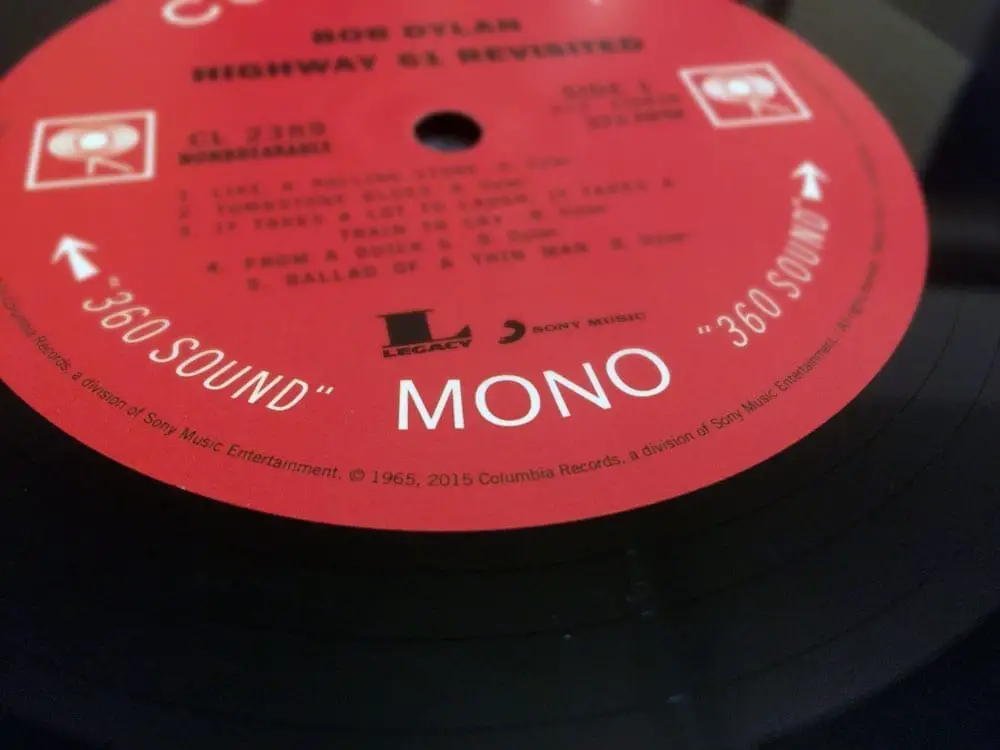
Often, the early use of panning from left to right is less than subtle. Hard panning could result in some instruments playing entirely in the left or right channel only, or in some cases—instruments or sounds passing quickly from one side to the other. Eventually, as stereo became to de facto standard, many older mono mixes were left behind, and in some cases, the only way to hear these versions is to find an old mono pressing of the record.
Here’s a classic example:
Listen to the drastic difference between the stereo and mono mix on the outro of Pink Floyd’s Interstellar Overdrive. The original mono mix is a natural dynamic lift on the opening riff, while the stereo version is one of the decade’s most infamous examples of extreme psychedelic stereo panning.
Like any new “gizmo”, or effect, the novelty eventually wears off, and restraint usually prevails. But the nostalgia for these original stereo mixes remains. In some niche instances, modern artists have deliberately paid homage. Check out this 2004 release from one of my favorite artists, John Frusciante, who intentionally referenced some of the early 1960s stereo records by hard-panning the drums to the right and the guitar to the left.
Back to mono. It’s easy to dismiss mono recordings as outdated, or inferior—particularly if you grew up after stereo’s decline, as I did. But contrary to popular opinion, mono records can sound fantastic, and even possess some sonic advantages over stereo records. When handled by a skilled engineer, mono recordings can sound especially focused, and punchy.
…And while modern stereo styli are backwards compatible with mono records, much of the acclaimed fidelity is lost without the help of a dedicated, true mono cartridge.
To understand the difference and potential benefit of using a mono cartridge, we must first understand the difference between each type of groove.
What’s the difference between a stereo and a mono record groove?
Mono records contain only lateral cut grooves with no vertical component. There is only one signal, and in simple terms, the groove goes from side-to-side without also going up and down.
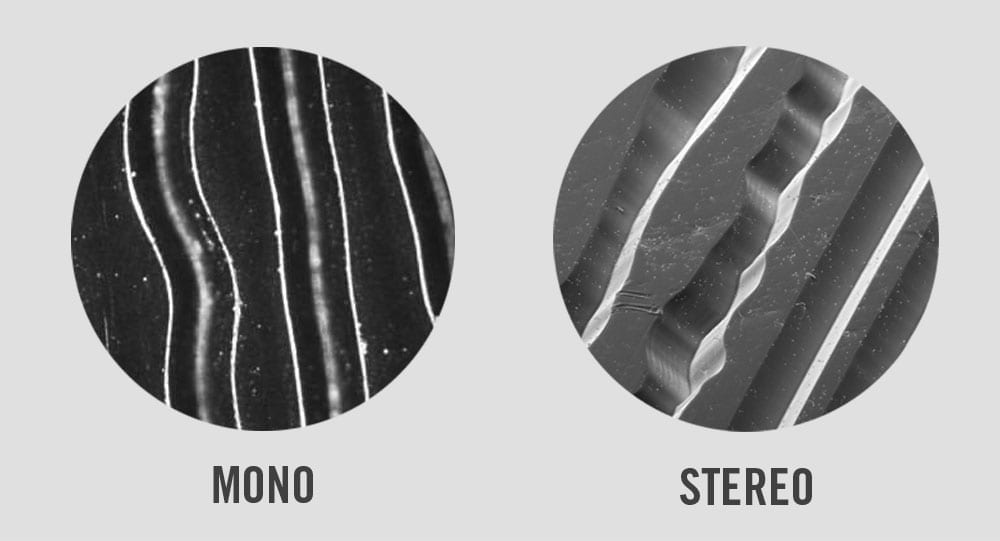
A stereo record contains separate left and right channel information on each groove-wall at a 45-degree angle from each other. The groove is a more complicated shape with both lateral and vertical information.
A mono cartridge should not be used to playback a stereo record unless the manufacturer states that it has both horizontal and vertical compliance; however, a stereo cartridge can easily play a mono record.
Why Bother with a Mono Cartridge then?
A mono cartridge is by far the best way to experience mono records. You could take the easy option and use a mono switch, but this will not fix the errors caused by a stereo cartridge never quite producing the same signal in both channels. In other words, playing a mono record with a stereo cartridge will not achieve the same signal in both the left and right channels. It will not be “true mono”. Imperfections such as crosstalk, phase errors, and tracking errors will result in a degradation of sound quality. Using a mono cartridge eliminates these problems by only producing one signal that is then distributed to both speakers on your stereo system. The signal in both your left and right speakers will be identical.
Using a mono cartridge can also reduce the response to dust and dirt substantially as any vertical element will not be reproduced. Often, the final result is a much cleaner reproduction of a mono record. Again, a mono switch cannot remove this noise—once the vertical element is tracked, it’s tracked, and this signal now has to be processed by the system whether you mono the signal retrospectively or not.
If ever there was a solid case as to why the signal source is more important than the signal output, this is it!
A Note on Stylus Size
Depending on when your mono records were cut, the bottom groove radius may vary. For example, older microgroove records from around 1950 could approach 15µm or larger. For optimum performance, I have read sources that indicate these records should be played using a spherical 25µm (1 mil) stylus to avoid the risk of a stylus “bottoming out” inside the groove and causing poor fidelity.
Depending on who you ask, you’ll get a different answer as to when the bottom groove radius of mono pressings reduced. In truth, the groove size can vary quite dramatically. As a general rule, mono LPs mastered before 1970 were likely intended for playback using a 1mil stylus. After this point, they are probably cut with a modern 0.7mil in mind. That being said, other sources appear to suggest that the radius of mono record grooves decreased over time, firstly down to around 8µm in the mid-50s, followed by 4µm as we approached the dominance of stereo. A modern 18µm (0.7mil) stylus is perfectly safe for playing back records of both specs.
In an ideal world, listeners would own both the wider and slimmer variety to account for different microgroove specs. However, if finances prohibit this, go for a modern 17-18µm (0.6 – 0.7mil) option.
Note: If you choose to own both (or you want to regularly switch from stereo to mono, you will, of course, require a tonearm with a removable headshell to make switching between multiple cartridges practical. Alternatively, you could run multiple turntables or tonearms.
Interestingly, some cartridge manufacturers suggest that, in some case, playing back older mono pressings with an 18µm (0.7mil) spherical, elliptical or line contact stylus may improve fidelity if the record was originally played heavily with a 25µm (1 mil) stylus. The theory works on the basis that a smaller stylus may replay the record in a different, unworn location of the groove.
Trying to determine the perfect stylus size for authentically playing back mono record pressings is somewhat of a minefield. However, in any case using a dedicated, true mono cartridge will invariably produce superior results to that of a modern stereo cartridge.
What Cartridge Should I Buy?
Ortofon, Audio Technica, & Grado all manufacturer a range of mono cartridges designed to authentically replay mono records. Ortofon, in-particular, offer a wide range to suit both purist and contemporary tastes.
For the purpose of this article, we’ll focus on a few select Ortofon models as a taster.
The 2M Mono is their staple offering, with a modern 18µm spherical stylus. Like so much of the Ortofon range, many of the styli are interchangeable. In this case, you could also choose to fit their 78 stylus option designed to play the wider-grooves of older 79 RPM records.
Check out our full review, here with audio samples.
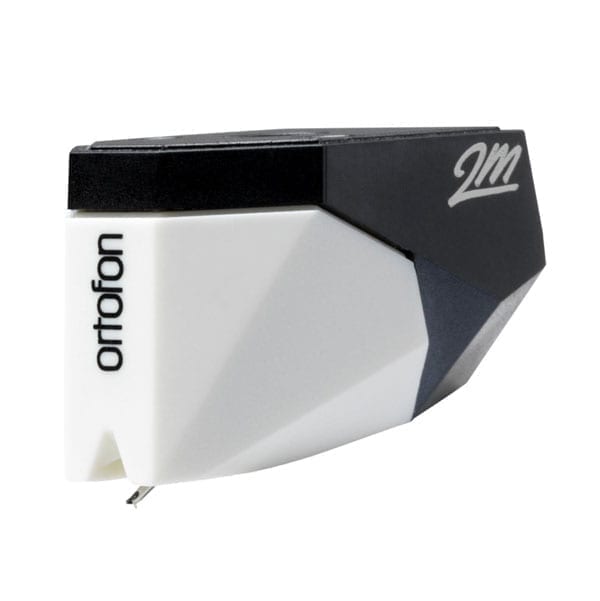
The purist mono enthusiasts among us may prefer the classic design of their SPU range, which feature an integrated headshell, designed to mount directly into classic tonearms with detachable “universal-fit” headshells. With a wider 25 µm stylus tip radius, they are best suited to older mono recordings.
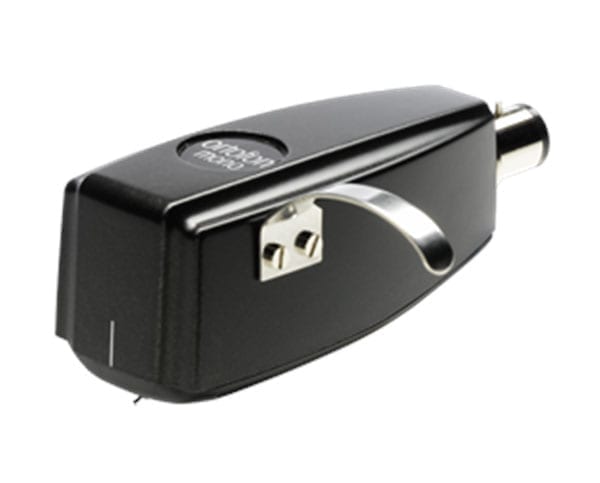
Lastly, Ortofon claims the 2M Mono SE (specifically created as a tribute to the Mono Beatles albums Set released in 2014) is a great option for playing both older and new mono recordings.
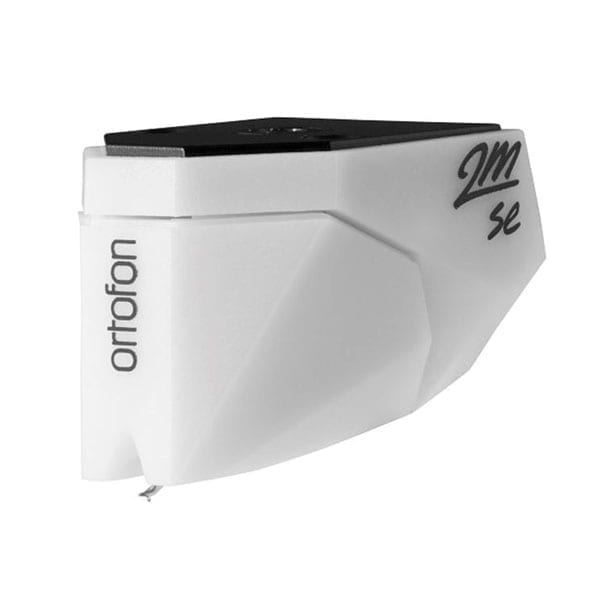

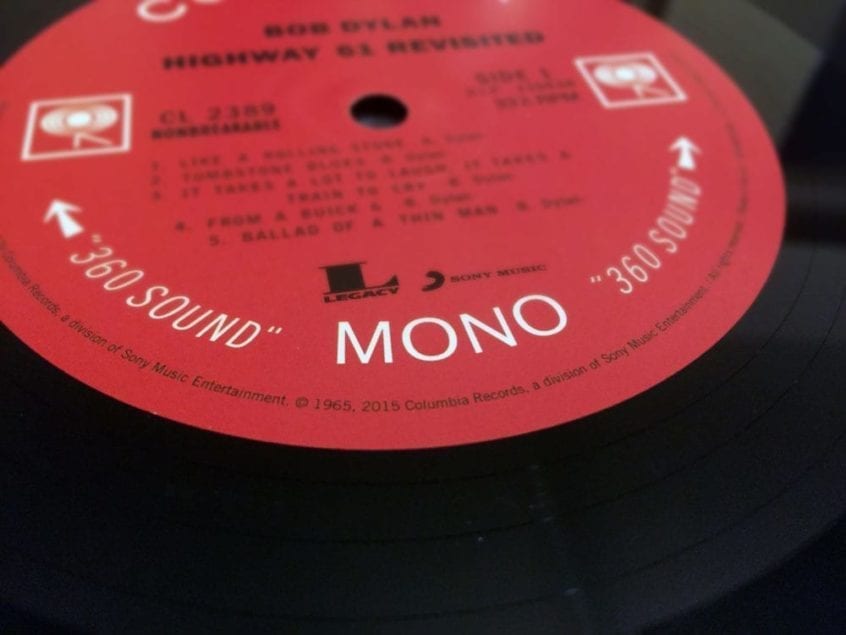


I recently inherited a two volume set of limited edition Glenn Miller LPs. Each volume appears to have 5 separate LPs inside. They were manufactured by RCA Victor in Montreal. The LPs themselves seem to be thicker than normal. They appear to be minimally played. There is no indication as to date and to play these, I was considering a mono cartridge. However, there is mention about different stylus sizes. What would you recommend for these?
Has anyone actually taken apart any of these purported “mono” cartridges to confirm they really are mono instead of sterero cartridges whose output has been strapped?
I’ve experience a peculiar effect from such strapping with 78 RPM records where the surface noise slowly drifts from one speaker to the other and back again.
Some mono cartridges are said to have horizontal coils as opposed to vertical or 45 degree coils. However, if the stylus has vertical compliance, then that signal is bound to get mixed with the music.
To the best of my recollection the GE VRII triple play, a true magnetic monophonic cartridge, had zero vertical compliance. It is unfortunate that no one has chosen to reproduce it, because it had the best sound of any 78 RPM cartridges I have ever used.
I have an Ortofon 2M mono cartridge. I put a D25M stylus in it against Ortofon’s instructions. I think it works well. What do you think?
I just learned that since the 60’s almost every mono or stereo record is made by using the stereo lacquer cutter head. I this case for mono records, do we end up with a typical mono groove with no info on the vertical direction? Or do we get a stereo groove with L and R channels containing the same info?
Well actually, during cutting two signals are fed into the cutting head: One is for lateral movement: L+R, one is for vertical movement: L-R. Yes, Sum and difference ! Whenyou do some basic geometry, you will find out, that these two signals actually produce 45 degrees tilted signals for the left and the right channel. And this leads to the answer of your question: Since – for mono – L and R are identical, there will be NO vertical modulation on a stereo record cut with a mono signal, but only a lateral one, like with a “true” mono cutting head. One topic to mention is of course the cutting tool: It is different for old mono records (approx. pre 58) and “new” mono records. Old groves sometimes look more like a “U” in profile while “new” ones have the “V” shape and therefore require other styli.
Do you remember the all-groove 2 mil styli of the 1950s? I haven’t owned one for 50 years but wonder how “newer” mono records would play.
Your article seems to be heavily citing a Deep Groove Mono article published three years earlier. If the author was citing that article, I’m sure the original author would appreciate acknowledgement.
As one of the first people in our street to install home stereo (even played with the Cook twin cartridge ‘Biknaural’ LPs circa 1955) ‘I detected a couple of errors in your article regarding the playback of monophonic (single channel) recordings.
Firstly, all other things being equal (proper stylus, reasonable magnetic cartridge), the quality of sound from a mono cartridge will be exactly the same as that of a stereo cartridge with the left and right channels connected in parallel.
There will be exactly the same reduction in vertical surface noise when playing a mono record of any speed (including shellac 78s) with either a parallel-connected two-channel cartridge or one of the dedicated mono types.
Where your theory went amiss was in assuming that a single channel cartridge responds to only lateral (side to side) modulation.
Not true.
If you played a test track that contained just one channel (either fully right or fully left) it would be heard equally well when played using a straight out mono or a parallel-connected stereo cartridge. Both would play through a stereo system through the left and right speakers at an equal level.
Even assuming the inherent crosstalk to be of no significance, the output of a stereo pickup does not comprise one left only and one right only channel. In reality, what is called the ‘left’ channel is actually the complete sound field minus only the extreme opposite (right) channel.
The one refed to as the ‘right’ channel is actually the complete sound field minus only the extreme opposite (left) channel.
Likewise, with both mono and parallel-linked stereo cartridges playback every angle of modulation (including left, right, lateral) EXCEPT the vectorial opposite vertical modulation.
In both cases, the completely vertical components of surface noise, clicks, pops is significantly cancelled. This can be readily appreciated when playing worn and/or damaged recordings, especially shellac 78s.
Finally (“at last” I hear you mutter), I think you will find that those simultaneously issued MONO and STEREO versions of LPs will, at least in the vast majority of cases, sound identical when played monophonically.
Record any two recordings of the same title, one that was issued in mono the other in stereo, onto a two-channel computer file (MP3, WAV or somesuch).
Next, combine each pair to a single mono channel. (This can be accomplished easily in almost any audio editor such as Amadeus or Audacity).
Now listen for any dissimilarity. You might find that if there is any, it would be subtle to the point of being insignificant.
You see, in all such cases I’ve heard, record producers never bothered doing a separate mix just for the mono release. No need to.
They just flipped a switch to combine left and right channels; just like anybody who has a ‘stereo-mono’ switch on their preamp can do.
I disagree with the prognosis that a stereo LP played by combining the two channels would sound identical to a mono pressing of the same album. This would be particularly false in the case of The Beatles’ albums, Motown releases, and albums from CBS labels, because the mono pressings weren’t just fold-downs of the stereo mixes, but DEDICATED mono mixes that differed from the same contents mixed for stereo.
Totally agree, Sgt Pepper is a prime example of two totally different recordings in Mono/Stereo. She’s leaving home is even played back at a different speed.
Hi All,
While I think I understand this, I’ve been looking for a nice diagram that really explains the mono/stereo options from cartridge to phono stage to preamp.
I have a Hana SL Mono cart going into an AA PPA-1 (stereo, no mono switch) into my stereo preamp and two speaker setup.
No older mono records that require pre-RIAA.
Am I missing something?
Am I correct in assuming that these recommended “mono phono stages”, aside from the pre-RIAA curves, are only “necessary” for a “true” mono setup with only one speaker?
Thanks for any feedback.
“You could take the easy option and use a mono switch, but this will not fix the errors caused by a stereo cartridge never quite producing the same signal in both channels.”
“Again, a mono switch cannot remove this noise—once the vertical element is tracked, it’s tracked, and this signal now has to be processed by the system whether you mono the signal retrospectively or not.”
I enjoyed your well-written article, though I believe you are oversimplifying the phenomenon of summing to achieve mono. Much noise is created by vertical motion, and vertical motion creates out-of-phase noise. And when you sum two out-of-phases signals, it gets cancelled. Summing also boosts the monophonic content (the music) 6 db more than the stereo content (noise). If you haven’t already tried, you might find that summing produces results comparable to using a modern mono cart with two realigned coils.
Exactly. And proper summing will indeed eliminate the vertical signal. A simple geometric analysis can demonstrate this. But, and this is important, it will only work 100% if the cartridge alignment is perfect and everything else is identical regarding the L and R channels. This is very hard to achieve in practice and this is the reason why a “true” mono cartridge is in most cases superior to a stereo cart with Y-Summing of L and R channels. There slight imperfections may lead to phase errors that will give you a non-focused sound with audible distortions ar even loss of important information. The human ear can be very sensitive to there things. So, if possible, try to get a “pure” mono cart that has its coils in a lateral arrangement. Btw. the Ortofon mono cart uses a stereo (aka the same as in all other 2M type carts) arrangement of the coils – it is NOT true mono but “strapped”!
Great article, thank you. Will a 1 mil stylus cause damage to later mono pressings? It sounds like it might just be “safer” to go with 0.7 mil since old LPs rarely identify themselves in this regard.
Tracking a mono album/single from the 60s with a .7 mil will cause extra noise from the record. Better to stuck with 1.0 mil if you can afford it. They are getting pricy. Even the needs for 78s is cheaper these days.
It’s a good read as I grew up in the 60’s and was a teenager in the 70’s.I have a lot of mono and stereo records.
I spin my (original) mono records with Ortofon 2M with great results, as described by you. However I am a bit confused by records that have labels like “enhanced stereo”, “living stereo” or “stereo also playable on mono”. All originally mono records to my knowledge. Can I spin these with my mono cart as well or is there a risk of damaging the stereo effect in the long run as I often read in expert articles?
Enhanced stereo is a mono signal with echo and /or EQ applied to make left and right sound different from each other.
“Stereo playable mono” is just a marketing line to make people in the sixties with mono gear buy stereo records (to play in mono initially and then hear in stereo when they upgraded their consoles).
“Living Stereo” was RCA’s marketing at the time announcing that they had perfected stereo vinyl record manufacture from actual stereo session tapes (damn good sounding ones, highly collectable even today 60 years later).
All the phrases you suggested, were usually cut with a stereo stylus so I would not play them with the larger mono needle.
Marc,
Great article. What should I be using with the new releases of past mono recordings? Example would be Mofi release of Ellington at Newport. This is a mono recording but a new pressing. What works best for new mono?
Hi Dave. The Ortofon 2M with a 18µm (0.7mil) stylus will suit the groove size of new mono pressings perfectly.
Thanks Marc. Really appreciate your help.
No problem at all. Happy listening!
Is the Shure M78S OK for mono since it is a stereo cart strapped for mono, I use a N35C stylus for the 45’s
Sorry for the slow reply. As long as you’re not using the 78 stylus (and it sounds like you’re not) you’re all good from what I can see.
18 µm = 0.7 mil, not 7 mil
Yep. We referenced 0.7, and then 7 as a typo. Now updated. Thanks for spotting that. Hope you enjoyed the article.
This Certainly is an interesting article per Mono Vs Stereo. Here are my thoughts. While only using my Stereo Cartrige which is plugged inmy Creek Phonostage through amplifier, I Can Absolutely tell the difference. Best example is Cream- Fresh Cream mono. It Blows away my Stereo copy and Stunned me with Delight! More to tell, but think if an individual has Hi End Audio Gear such as myself, You can STIll hear the difference.
Cheers!
Hi Andrew. Thanks for sharing. That’s great. Sounds like you’re getting satisfactory results through that phono stage. Glad to hear you’re enjoying some mono classics! Happy spinning.